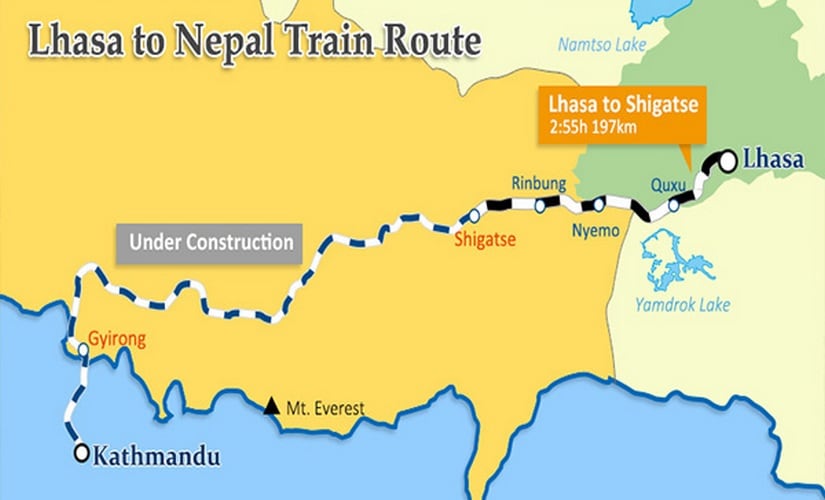When the idea of a China-Nepal railway was first floated, it seemed like the project would not see the light of day. The technical odds of building the railway through some of the highest and most precarious mountains seemed too high and the political will to see through the project couldn’t be relied upon. The proposed Trans Himalayan railway, that will connect Nepal to China’s land and sea ports, would have to go through a terrain and altitude that makes construction highly challenging even for the Chinese, who are known for their engineering prowess. A recent joint Nepal-China technical study estimates that the Gyirong-Kathmandu train line would cost Rs 257 billion to build and a period of nine years to complete. Of the 72.25 kilometre track that would be constructed inside Nepali territory, a major section would have to be built on tunnels and bridges owing to the treacherous geography and earthquake risks. Technical challenges aside, critics also question the economic rationale of China wanting to build a multi-billion railway through Nepal when it could easily access Indian markets through sea routes. There was also the question of whether Nepal would risk vociferous Indian opposition to pursue the costly rail project with China. In all likelihood, the project seemed like a distant dream that wouldn’t go beyond speculation and sloganeering. But with progress on the Shigatse to Gyirong trainline which is expected to complete by 2020, and a series of agreements, joint meetings and preparatory works underway between the two governments to extend the rail line, suddenly the train to Kathmandu is looking less and less far-fetched. Particularly in Nepal, the railway is being seen as a game-changer, not just for its potential to increase trade and connectivity but also for the role it will play in ending India’s chokehold on landlocked Nepal as its only access to sea. Nepali industries are concentrated on the southern plains and given their relative closeness to Indian ports, businesses would most likely continue using them over Chinese options further away, but Nepal’s hope is that apart from new trading opportunities, the railway will offer a crucial lifeline against potential Indian blockades. The idea of a Trans Himalayan rail link first gained traction after India imposed an economic blockade against Nepal in 2015, cutting off fuel and essential supplies for nearly five months. Nepal was forced to seek alternatives, which it promptly did by turning north. By March 2016, the country’s prime minister KP Oli had signed ten major agreements with China on mostly infrastructure and connectivity projects. Seen against this backdrop, it is not surprising that Nepal seems determined to build the cross-Himalayan rail despite high costs and the technical hurdles. There have been a number of assumptions about why China wants to build the railway, ranging from purely economic reasons to China’s strategic interests having to do with Tibet to the supposed Chinese desire to predominate South Asian politics. But for Nepal, the goals seem fairly clear. Nepal wants alternative sea access as well as an opportunity to be a part of the Chinese growth train. Eventually, Nepal plans to extend the railway line to India and reap benefits as a major transit point for India-China trade. The Gyirong-Kathmandu railway, if completed, will have the potential to change the region’s political and economic landscape and with careful planning and foresight, Nepal could potentially leverage the new linkage to transform its politics and economy. But given the state of affairs, there are also increasing concerns within Nepal on whether the Himalayan nation could engineer such access and benefit from it, and more significantly, if Nepal runs the risk of turning into a geopolitical scapegoat without much to gain from the undertaking. [caption id=“attachment_5805811” align=“alignnone” width=“825”]  Train route from Lhasa to Kathmandu. Image procured by Rubeena Mahato[/caption] An immediately apparent problem is the lack of clarity on how the project would be financed. There is a growing concern on whether the project would land Nepal into Chinese debt. Nepal has wanted the Chinese to fund the project through grants while China has hinted at the possibility of soft loans. So far, Nepali leaders have refused to buy into fears about China’s “debt trap diplomacy” mostly raised in Indian and Western circles, but it is crucial to have a good sense of where Nepal stands in terms of its capacity to pay for the project. Second, the issue of financing becomes even more important when seen in the light of the government’s plan of developing the country as a transit point. Without commensurate plans to develop niche markets for its products, there is a fear that Nepal might end up being merely a stopover on a railway that it has paid to build with little value to add. For China, the railway through Nepal provides the advantage of the shortest and easiest route to the huge markets of North India, which it hopes to open for its comparatively underdeveloped western provinces. Nepal needs to be equally clear about what it wants to gain and how it would seek to maximise opportunities for Nepali businesses. There is also much talk about how the railway would attract trainloads of Chinese tourists to the country but little discussion on how Nepal plans to navigate the demographic pressures that a greater link with China would inevitably bring. Third is the question of how Nepal plans to benefit from the project in terms of human capital development and building state capacity. How would the project engage and develop Nepali expertise, if at all? Public confidence in the government’s capacity to see through major projects is at an all-time low, given the dismal state of basic infrastructure inside the country. Having witnessed every mega-project turn into a cash-cow enriching politicians, contractors and businessmen with nothing to show after decades of work, Nepalis are naturally sceptical of the government’s capacity to build anything substantive. Much of the opposition to the rail project has actually stemmed from this suspicion and it will be on Oli’s government to prove such fears wrong. Despite these challenges, the railway offers a promise that Nepalis have long held on to, of benefitting from their strategic location to become the bridge between India and China. Whether or not the project would be a game-changer as is being hoped for in Kathmandu is too far into the future. But at least for now, Nepalis seem determined to push ahead with their railway dream. (Rubeena Mahato is a Nepali writer. She writes on global politics and development)
In Nepal, the railway is being seen as a game-changer, not just for its potential to increase trade and connectivity but also its role in ending India’s chokehold.
Advertisement
End of Article


)

)
)
)
)
)
)
)
)



